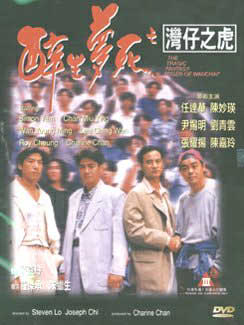The Tragic Fantasy: "Tiger
of Wanchai"

Reviewed by YTSL
A couple of weeks ago, I finally checked out --
and was blown away by -- the brooding offering entitled “To Live and Die
in Tsim Sha Tsui”. When I told a fellow Hong Kong movie fan about this,
he said something to the effect of “considering the large number of Triad
films that you’ve already seen, it’s amazing that there are still some that
can get your blood going!” After having viewed another Triad drama
that was released -- like that Andrew Lau helmed effort in which Jacky Cheung
turned in a surprisingly effective performance -- in 1994 (and actually ended
up 13 rungs above it by getting in at no. 31 on that year’s Hong Kong box
office list), I’d have to agree with my friend that many of this once popular
genre’s works can seem too similar and thus not feel like they are bringing
anything “new” to the table.

Perhaps the core story of THE TRAGIC FANTASY: TIGER OF WANCHAI would not
have felt so old if I hadn’t viewed the later made “Young and Dangerous”
series of films before that whose protagonist is an apparently “based on
real life” character who went from being a lowly “parking boy” to a powerful
gangster whose life remained in constant danger due to his having as many,
if not more, disgruntled rivals than true friends. As things turned
out, it was interesting -- plus hard to not notice -- that three out of this
effort’s four main actors also do feature in that Triad glamorizing group
of cinematic works which made a major star out of the oft-criticized Ekin
Cheng. At the same time, it was somewhat fascinating too to see Lau
Ching Wan having the quite atypical -- for him -- (supporting) role of a
gambling addict with a cowardly streak along with good buddies (who came
in the form of Simon Yam, Vincent Wan and Roy Cheung).

By some accounts, any movie that can boast having Mr. Lau -- never mind other
fine actors -- in its cast should be more than a run of the mill one.
In this case though, my feeling is that many of the talents who appeared
in THE TRAGIC FANTASY: TIGER OF WANCHAI ended up getting let down by the
admittedly eventful, but ultimately far too predictable, offering’s uninspired
script. In particular, this (re)viewer rues its screenwriting trio’s
decision to rather abruptly shift the focus of the main story fairly early
on in this Steven Lo and Joseph Chi co-directed work from one that gave equal
attention to the four “heng tai” named Hing, Dee, Hung and Chung -- and thus
benefited from having more than one talented individual being asked to carry
(that portion of) the film -- to that which gave center-stage pretty much
entirely to Simon Yam’s highly temperamental Hing character.

Not far behind on my “wrong turn” list would be that which sought to throw
some love and sex elements into the Category III rated -- for violence? --
picture by having Hing get involved with an arguably feisty female called
Mil Mil (played by Marianne Chan) and a fallen woman named Kitty (essayed
by Yvonne Yung Hung). It’s a pity too that veteran actor Lo Lieh’s
snake-ish (Elder) Brother Kui character and also Ben Lam’s bombastic (elder)
Brother Yeung ended up not getting more screen time than they did (even while
both “dai lo”s were able to amply show how heartless -- and deserving of
violent deaths -- they were in their temporally limited appearances in the
film). Still, these individuals did have a greater impact on the proceedings
of that whose Chinese title translates into English as “The Drunken Death
Dream of the Wanchai Tiger” than the almost entirely superfluous character
portrayed by the actress who looked to have also been the watchable but not
special movie’s executive producer (Charine Chan’s Fannie invariably played
second fiddle to characters who already were but support ones vis a vis this
offering’s principal personality).

All in all, about the one thing that I found somewhat “novel” about the not
very sophisticated -- and particularly with regards to its use of Cantopop
montages -- THE TRAGIC FANTASY: TIGER OF WANCHAI were its fight scenes.
Not only did these well-choreographed portions of the movie benefit from
the likes of Ben Lam figuring in them but they also are not filmed in the
blurry, “shaky-cam” and “jump cut” style made famous by Wong Kar Wai and
popularized by cinematographer-director Andrew Lau and others. Ironically,
this probably is really because this Peter Ngor Chi Kwan lensed as well as
executive directed work -- which came out in the same year as “Chungking
Express” and “Ashes of Time”, and was a bigger commercial hit than either
of those critically acclaimed efforts -- was made before that latterly much
imitated cinematographic style became the vogue.

My rating for the film: 6.






